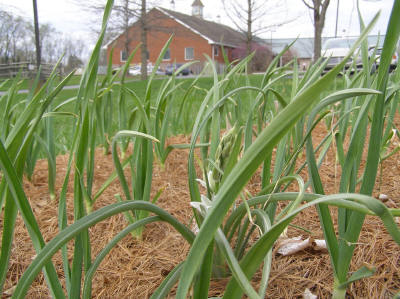
If you read my articles about planting garlic published last fall and decided to grow some yourself, you’re in for a surprise this spring. Check your garden and you should see onion-like leaves already up and growing. The garlic bulbs planted last fall in the Adams County Ag Center’s Trial Gardens on Old Harrisburg Road are now 4-6 inches tall and have full leaves
showing. (See accompanying photo.) The plants have reached about ¼ of their mature height. The cold chill of recent Adams County nights cannot harm a garlic bed. Even now, snow or ice will not hurt the hardy garlic.
For now, what’s there to do? At this point, concentrate on feeding, watering and mulching your garlic. If you notice exposed soil, put down additional mulch along the garlic rows to protect the garlic shoots. They will require water at a rate of 1 inch per week, which can be supplied by watering, if rainfall is sparse. Garlic plants extract much energy from the soil
maturing over the next 10-12 weeks If the soil was amended with compost when the cloves were planted last fall, fertilizing is unnecessary at this time. If fertilizing was omitted last fall, a light side-dressing between the rows using finished compost or well-rotted manure will provide a boost to the soil for the plants’ nutrition.
Weeding is relatively easy if the bed was well-mulched last fall. If weeds have penetrated around the plants, carefully remove the weeds so as not to disturb the growing bulbs beneath. Garlic heads grow better if they do not have to compete with weed roots. Do not use an herbicide to try and reduce weed growth around the garlic plants, as the chemical will jeopardize
the growing bulb beneath the soil.
 The garlic, which grows to 24-30 inches depending on the variety, will remain erect and upright through its growing cycle. In early June, some varieties, usually the hard-neck garlics, bloom a flowering stalk called a scape. The flower is white and plain. The bulbs will grow larger if these blooms are
removed with shears or a knife. A bonus of flower removal is that they are edible. Two favorite ways to use scapes is to stir-fry the chopped stem and flowers in olive oil and fold in a couple of beaten eggs to scramble. You can also put the raw chopped scapes in oil and vinegar and use as a salad dressing. It would be wasteful to snip off the scapes and not try these
tasty treats.
The garlic, which grows to 24-30 inches depending on the variety, will remain erect and upright through its growing cycle. In early June, some varieties, usually the hard-neck garlics, bloom a flowering stalk called a scape. The flower is white and plain. The bulbs will grow larger if these blooms are
removed with shears or a knife. A bonus of flower removal is that they are edible. Two favorite ways to use scapes is to stir-fry the chopped stem and flowers in olive oil and fold in a couple of beaten eggs to scramble. You can also put the raw chopped scapes in oil and vinegar and use as a salad dressing. It would be wasteful to snip off the scapes and not try these
tasty treats.
All things considered, garlic is a low-maintenance crop. As you watch the plants mature, use the weeks ahead to plan for supplies needed when harvest is at hand. To make this part of the process easier, plan carefully where the garlic can be laid or hung after harvest. Ideally, you want a cool, dry place out of direct sunlight with good air flow. Mentally organizing
how and where to cure and store garlic will make cultivating garlic flow more smoothly.
Between now and when the garlic is removed from the bed, I collect mesh produce bags, large pieces of cardboard, string, boards, and I clean-out one of the bays in my garage to use as a drying space. Elevating old window screens a few inches from the floor or ground works well for a place to dry garlic. Other spaces which work for curing and drying are covered porches,
barns or sheds. My mother would set up a couple of old picnic tables or use saw horses and boards under a dense pine wood and hang a tarp canopy over the tables to keep rain off the drying space. Garlic can lay on tarps on the ground and be covered with another tarp at night and uncovered each morning. Yet another way to dry the garlic is to tie in bunches and hang on a
drying rack or from rods secured to rafters.
Devising a curing space provides a lot of leeway depending on one’s imagination, ingenuity, and the amount of garlic to cure. Garlic requires 2-4 weeks to cure and depends on the environment’s temperature and humidity during the process. Curing allows the bulbs to dry and harden and enhances storage time. If garlic is wet and stored prematurely, it will rot or mold in
storage.
Upcoming weather conditions determine when to pull garlic out of the ground in mid to late June. For now, keep the garlic bed weeded and watered if rain is sparse. Remove and eat blooming scapes as they appear and plan for where and how to cure and store the crop.
(The article referred to in the first paragraph can be accessed by going to www.emmitsburg.net/gardens/authors.htm and clicking on the title "Garlic 101 Reasons to Develop a Bed" under my name. There you can learn about the different kinds of garlic, their various uses, how to amend the soil for good garlic growth, siting the garlic properly and mulching it for
protection against harsh winter weather.)
Read other articles on growing herbs or vegetables